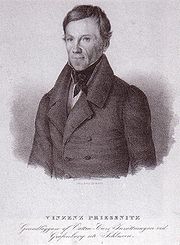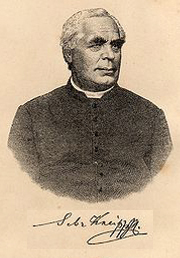Fr. Sebastian Kneipp and Hydrotherapy
Hydrotherapy, formerly called hydropathy involves the use of water for soothing pains and treating diseases.
 The use of hydrotherapy as a healing modality has been evident throughtout human history. It has been recorded in the civilizations of the ancient Egypt, Greece and Rome. Eessential oils and flowers were commonly used in the baths among Egyptian royalty. The Romans provided communal public baths for their citizens for the sake of basic hygene. Hippocrates and others prescribed bathing in spring water for sickness.
The use of hydrotherapy as a healing modality has been evident throughtout human history. It has been recorded in the civilizations of the ancient Egypt, Greece and Rome. Eessential oils and flowers were commonly used in the baths among Egyptian royalty. The Romans provided communal public baths for their citizens for the sake of basic hygene. Hippocrates and others prescribed bathing in spring water for sickness.
The two main protagonists of the methodical application of hydrotherapy are Vincent Priessnitz, who, in around 1829, revived it, poplularizing it once more and Fr. Sebastian Kneipp. It is interesting to note that Vincent Priessnitz was a peasant farmer in Gräfenberg, a German speaking town that is now part of the Czech Republic and Kneipp was a Bavarian priest.
This revival was continued by Fr. Sebastian Kneipp, “an able and enthusiastic follower” of Priessnitz, “whose work he took up where Priessnitz left it”, after he came across a treatise on the cold water cure. Kneipp’s own book My Water Cure was published in 1886 with many subsequent editions, and translated into many languages.
The use of water to treat rheumatic diseases has a long history. It continues to be used as an adjunct to therapy, including in nursing, where its use is now long established. It is used to treat musculoskeletal disorders such as arthritis, ankylosing spondylitis, or spinal cord injuries and in patients suffering burns, spasticity, stroke or paralysis. It is also used to treat orthopedic and neurological conditions in dogs and horses and to improve fitness.
According to the International SPA Association (ISPA), hydrotherapy has long been a staple in European spas. It’s the generic term for water therapies using jets, underwater massage and mineral baths (e.g. balneotherapy, Iodine-Grine therapy, Kneipp treatments, Scotch hose, Swiss shower, thalassotherapy) and others. It also can mean a whirlpool bath, hot Roman pool, hot tub, Jacuzzi, cold plunge and mineral bath. These treatments use physical water properties, such as temperature and pressure, for therapeutic purposes, to stimulate blood circulation and treat the symptoms of certain diseases.
Fr. Sebastian Kneipp himself was a very sickly child. One day in winter he fell through the ice on a river and got completely soaked. Knowing how prone he was to being sick, he hurried home. The more he hurried the warmer he got and the better he felt. He repeated this cold water therapy until his health was completely restored. He became a believer and proceeded in time to help others with his growing knowledge of the use of simple water therapy.
 Sebastian Kneipp was a Barvaian priest born in 1821 in Stephansried, Germany. He was one of the founders of the Naturopathic medicine movement. He is most commonly associated with the “Kneipp Cure” form of hydrotherapy, a system of healing involving the application of water through various methods, temperatures and pressures.
Sebastian Kneipp was a Barvaian priest born in 1821 in Stephansried, Germany. He was one of the founders of the Naturopathic medicine movement. He is most commonly associated with the “Kneipp Cure” form of hydrotherapy, a system of healing involving the application of water through various methods, temperatures and pressures.
In Norway he is mostly known for his bread recipe based on whole wheat. Kneipbrød (Kneipp Bread) is the most commonly eaten bread in Norway.
Although most commonly associated with one area of Naturopathic medicine, Kneipp was the proponent of an entire system of healing, which rested on five main logical and common sense tenets:
- Hydrotherapy
- Herbalism – The use of botanical medicines.
- Exercise
- Nutrition – A wholesome diet of whole grains, fruits & vegetables with limited meat
- Spirituality – Kneipp believed that a healthy mind begot a healthy person
During his time in Bad Wörishofen, Kneipp was able to counsel many people. Tens of thousands came from all over the world to receive his healing advice. He was the author of the books “My Water Cure”, “Thus Shalt Thou Live”, and “My Will.”




